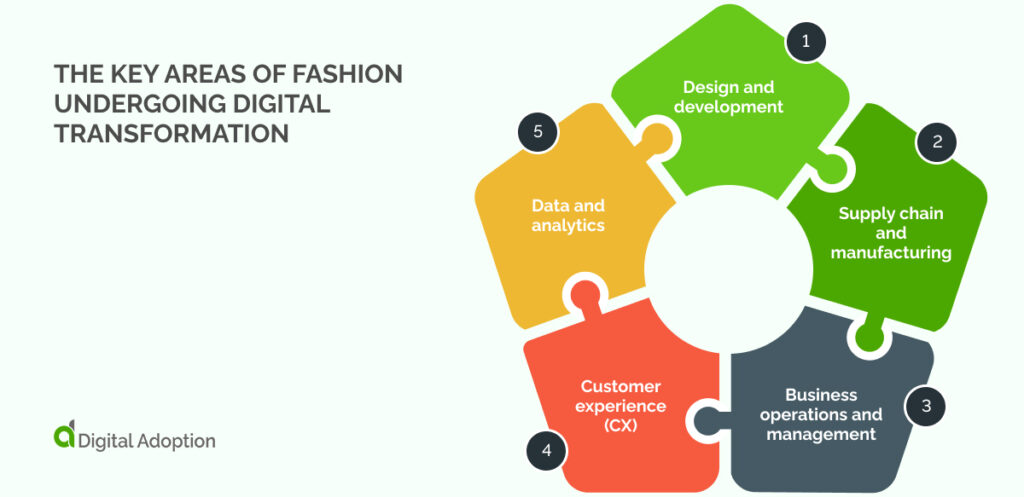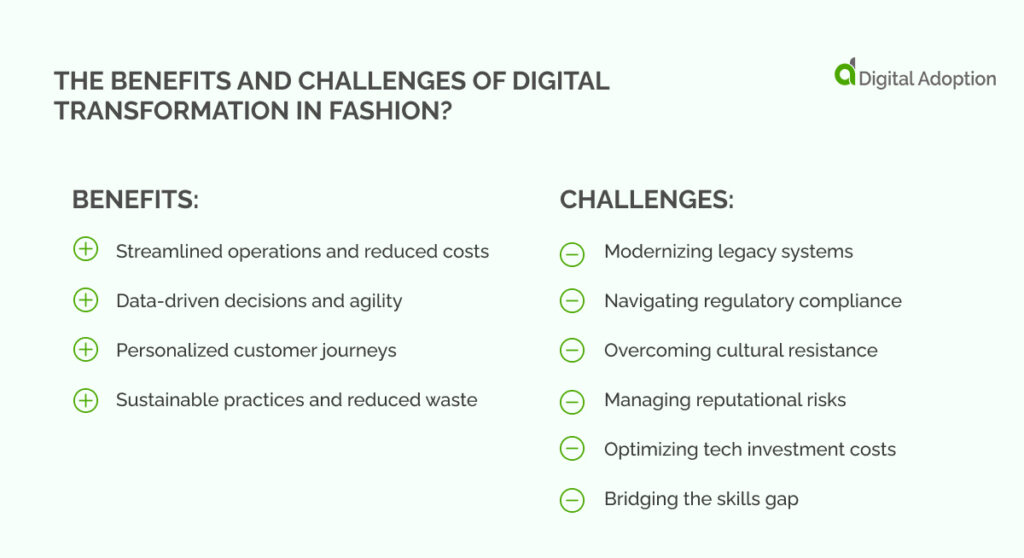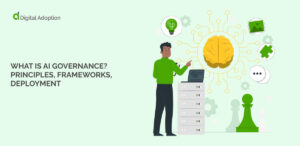Fashion trends change constantly. Every passing day, every new season—the race to be at the forefront of innovation means competition is lighting-fast.
Fortunately, today’s rapid digital developments can match the speed of innovation in fashion.
Timing is key, and fashion is undergoing a digital transformation like most other major industries.
AI can now assess customer behavior. By analyzing behavior, it can predict buying habits and automate tasks to boost productivity. Elsewhere, VR and AR are reimagining the customer experience, and shopping is also getting a virtual upgrade.
Customers can now step into immersive worlds and interact with lifelike versions of the products they love.
A shared pursuit of the cutting-edge means digital transformation in fashion is a dream match. In the fashion world, styles and trends change with the seasons. However, digital transformation is a different race altogether.
This article explores the crossroads of digital transformation in fashion. We’ll analyze what digital transformation means for fashion and identify key areas undergoing change. We’ll also examine some examples of the technologies impacting the industry.
- What is digital transformation in fashion?
- What are the key areas of fashion undergoing digital transformation?
- What are some examples of digital transformation in fashion?
- What are the benefits of digital transformation in fashion?
- What are the challenges of digital transformation in fashion?
- The future of digital transformation in fashion
What is digital transformation in fashion?
Digital transformation in fashion involves transforming organizational and operational processes through digital technology. This includes enhancing technology adoption and improving customer experiences. It can also include introducing new business models to generate new value.
Today, transformation efforts in the fashion industry are seeing physical apparel designs and virtualized mock-ups. This heightens productivity and creativity for artists and sewists during the design process.
AI analyzes garment patterns to create optimized fabric cuts, minimizing waste by up to 30%. Robotic process automation (RPA) takes the monotonous task of intricate sewing off human hands. This goes a long way in enhancing quality assurance. It also allows the designers to redirect their efforts to more high-value activities.
According to McKinsey, fashion companies are projected to more than double their investment in technology by 2030. Investments are rising from 1.6-1.8% of revenue spent in 2021 to 3.0-3.5%.
What are the key areas of fashion undergoing digital transformation?

Fashion’s digital transformation has seen sketches switched out for 3D design software and sewing machines swapped for robotic arms.
Like most other industries, technology is embedded in every aspect of the fashion sector. Digitalization is steadily advancing in fashion. This transforms how customers interact with brands across the entire fashion value chain.
Here’s a closer look at how digital transformation is reshaping five key areas in fashion today:
Design and development
Intuition still plays a role, but data is becoming a powerful design partner. AI and data analytic capabilities comb vast datasets to predict trends and customer preferences.
Leveraging this data means designers can anticipate customer trends. They can also target campaigns with more accuracy. 3D design software accelerates the D&D process with virtual prototyping.
This removes the need for physical mock-ups. It lowers waste by allowing teams to make digital revisions before production begins.
Supply chain and manufacturing
AI algorithms detect patterns in data and fabric. AI tools can now analyze fabric patterns to optimize cutting plans. This helps save resources, reduce waste, and ensure sustainable production.
Robotics enables the talent force to focus on the intricate details that define high-quality fashion. It does this by taking over monotonous tasks like sewing and assembly.
Blockchain technology’s watertight record-keeping capabilities put transparency front and center. Distributed ledgers on the blockchain store information that can’t be changed or deleted. It creates high visibility of materials and production processes throughout the supply chain.
This transparency enables better accountability and ensures ethical and sustainable practices. It gives customers the confidence that their clothing is produced responsibly.
Business operations and management
Cloud services are the go-to for companies looking to fast-track transformation, given their flexibility and availability,
These flexible and readily available solutions streamline business processes. They accelerate the design and development process from inspiration to production. This centralization enables real-time resource optimization and better decision-making fueled by data-gleaned insights. This agility results in lightning-fast responsiveness to market shifts and shifting customer wants.
Cloud adoption extends beyond design and development. Customer relationship management (CRM) platforms are also being overhauled. Static customer profiles are being replaced by dynamic data collection. They are giving brands a more enriching understanding of their audience.
Customer experience (CX)
Customer centricity is one of the biggest drivers of digital transformation in fashion today. The focus shifts from seasonal collections to personalized online experiences. This allows customers to explore and connect with brands from anywhere.
Interactive platforms dismantle the one-way communication of traditional retail. Launch social media campaigns that don’t just showcase products but invite feedback and suggestions. This two-way conversation allows for co-creation. It gives businesses customer insights that inform design decisions and product development.
Digital tools like VR and AR empower informed choices. They let customers visualize garments based on their body type or integrate them into their existing wardrobe.
True digital transformation occurs when fashion and technology combine to empower customer expression. This radical approach to CX builds customer confidence. It allows customers to feel like valued partners in the fashion experience.
Data and analytics
Engaging customers becomes a whole lot easier with the help of data analytics.
Many companies have long used blanket market campaigns without any way of gaining insight into customer preferences. The guessing game has often led to broad demographic segmentation and mass-market campaigns. Instead of throwing the same styles at everyone, brands are getting to know their customers on a deeper level.
Detailed customer data can be gleaned to give a more precise picture of customers’ preferences. Every click, purchase, and social media interaction becomes a data point.
Analysts can then easily leverage this rich pool of information to analyze and anticipate customer needs.
The result? Expertly tailored recommendations and personal marketing campaigns have become the norm.
Interactive platforms are transforming the customer role from passive observer to active participant. These customer-facing portals empower consumers to co-create with brands. It allows them to leverage valuable customer insights into product development and key design decisions.
This positions customers as valued contributors in the fashion evolution.
What are some examples of digital transformation in fashion?
We’ve explored how today’s digitally driven world is spurring transformations in the fashion world.
Now, let’s explore some examples of how the fashion sector is embracing digital technologies to affect positive change and overhaul operations.
To understand how fashion is changing, we’ll explore different technologies accelerating transformation. We’ll dive into specific examples of technologies boosting efficiency for fashion companies. We’ll even hear real-world stories from companies that have leveraged them to their advantage.
Let’s jump in.
Apparel business management software
Apparel business management software provides a centralized platform for core activities. These include order processing, warehouse fulfillment, inventory management, and customer care.
Fashion businesses are embracing apparel business management software as a key digital tool. This software’s centralized capabilities are accelerating the transformation of the entire fashion sector.
Lightspeed Retail is a point-of-sale inventory management system. It’s ideal for brick-and-mortar businesses with physical stores. Their easy-to-use software and friendly UI enable retailers to navigate features. These include inventory and tracking, customer management, and analytical insights on sales and customer behaviors.
British-based luxury fashion boutique Phoenix Style swapped out its “very clunky and very basic” point-of-sale system for Lightspeed Retail in 2017. Following this partnership, the vintage retailer experienced major growth. It expanded from a single store to two locations, experienced an 85% jump in revenue, and quadrupled its customer base.
Apparel design software
The latest apparel design software empowers today’s designers to unleash their digital creativity. These tools are revolutionizing fashion design by offering new possibilities for digital creation.
They allow for unlimited experimentation and iteration of ideas in a 3D environment. Designers can now access virtual garment prototyping. They can build 3D models, drape fabrics virtually, and adjust designs in real-time. Some programs even generate flat patterns automatically.
For example, CLO 3D is 3D fashion design software used by industry leaders like Adidas, Alders, and Abitek. Macron, a European sportswear leader, uses CLO 3D to improve design and reduce errors.
Head of Pattern and Technical Manager Roberto Malatesta says,”3D visualization enables us to identify any issues in the assembly of the garment, supporting the designer in defining the details and proportions.”
Digital sourcing platforms (DSP)
Once designs are finalized, finding the right manufacturing partner becomes critical. Digital sourcing platforms (DSPs) bridge the gap between fashion brands, suppliers, and manufacturers worldwide.
These digital tools are becoming non-negotiable in fashion procurement processes. Procurement is evolving. Digital sourcing platforms (DSPs) are going beyond just eProcurement and eSourcing.
They’re now offering a wider range of tools to streamline the entire process. This includes functionalities like supplier vetting, real-time production tracking, and integrated quality control. It also includes promoting collaborative communication with suppliers.
Overall, DSPs provide transparency, efficiency, and diverse sourcing options. They allow brands to find the ideal match for their production needs.
Automated quality control
Maintaining consistent quality is key, especially for brands whose reputation it relies on.
Automated quality control systems use a network of sensors and AI-powered image recognition software to scan garments for defects.
These digital tools fast-track transformation efforts with AI-embedded features that automate error detection. This mitigates any quality inconsistencies before releasing products.
Intellect is a well-trusted enterprise quality management software that helps fashion brands ensure a smooth quality control process.
Intellect offers a configurable platform for managing various aspects of QC. Users can manage document control, audit trails, inspections, instrument calibration, and inventory within a single system. Notably, Intellect integrates compliance controls designed to meet regulatory standards.
AI-powered inventory management
Optimizing stock levels is a constant balancing act. Holding too much inventory ties up capital, while running out can lead to lost sales.
AI-powered inventory management systems analyze historical sales data and consumer trends. They can make stocking recommendations and accurately predict demand. This minimizes waste and ensures products are readily available when customers want them.
Inventory management software utilizes AI to make real-time recommendations. It can optimize stock allocation, replenishment strategies, and automatic reordering. This minimizes excess stockpiling, ultimately boosting profitability.
Zoho Inventory, an AI-driven inventory management system, provides a central platform for various features. These include item management, customer lifecycle, vendor relations, AI automation, and stock-level monitoring.
Priyal Bafna, Senior Manager of Finance at Rapido Bike, India, says, “We have been able to simplify our in-house inventory management with increased efficiency and flexibility across the stock distribution process, and this has helped us keep our captains engaged […] .”
Enterprise Resource Planning (ERP) Software
Success for today’s fashion brands relies on a multitude of moving parts.
Enterprise Resource Planning (ERP) software emerges as the go-to platform for ensuring smooth operation in this complex arena.
ERP software has long been a mainstay in the digital arsenal of big businesses, making it a key asset in many digital transformation efforts.
ERP software can glean real-time insights on everything from raw materials to finished goods. In-depth data analysis tools also support enhanced decision-making on pricing, product development, and marketing campaigns.
SAP S/4HANA is an example of ERP software helping the fashion world transform. It minimizes data storage, speeds up transactions, and delivers real-time insights. This translates to faster financial closing, better quality control, and meeting IFRS 15 standards.
Digital showrooms
Digital showrooms offer an immersive alternative to geographically restrictive in-store showrooms. Imagine virtual spaces where buyers can explore entire collections in 3D. Customers can interact with individual items in incredible detail and create custom styles.
Digital showrooms will come alive with virtual reality (VR) and augmented reality (AR). Customers can experience personalized spaces and cultivate the ideal shopping experience.
This innovative technology offers a triple win. It strengthens brand presentation, expands customer reach, and reduces the environmental footprint by minimizing physical travel.
COVID-19 health precautions pushed BMW to prioritize safety when it launched its digital car showroom. For those unable to visit dealerships, BMW created The BMW Digital Showroom, a virtual space for customers to explore car models. This online experience offered a convenient alternative to the traditional brick-and-mortar showroom.
Faced with a drop in physical showroom visits, BMW found a way to maintain customer engagement: The BMW Digital Showroom. This online platform provided a virtual space for car exploration. It keeps customers connected even when global social interaction is limited. Visitors could browse models in detail, similar to a physical showroom experience.
Web-based features facilitated communication with dealers, allowing questions and personalized guidance. The showroom offered the option to schedule private viewings or test drives directly after finding the desired car. This helped streamline the buying journey.
Digital clienteling software
Digital clienteling software is making transformation in fashion light work.
Digital clienting software, sometimes confused with CRM, offers a richer view of customers. It goes beyond basic data like preferences, capturing their entire digital footprint. Browsing behavior, past interactions – everything is tracked, creating a 360-degree view. This deep understanding lets companies personalize experiences and build stronger relationships.
Take Salesforce Commerce Cloud as an example. This platform leverages customer data to personalize the shopping experience. While browsing, it recommends complementary products based on your interests. It analyzes past purchases to suggest personalized discounts and even predicts potential checkout issues. This ensures a smooth buying journey.
This positions retailers to deliver better customer experiences and drive brand loyalty.
Predictive analytics technologies
The post-digital age means the fashion industry is brimming with data. Predictive analytics technologies tap into the power of this information. They support future decision-making through analytical insights.
These tools offer future trend prediction capabilities, optimized marketing campaigns, and bespoke product development for each customer.
For example, IBM SPSS is a predictive analytics tool that can help fashion houses decipher trends from a ton of customer data.
This helps optimize inventory levels, minimize dead stock, and deliver the right products to the right customers at the right time.
Augmented body measurement software
Augmented body measurement software ensures customers get the right fit for their products without stepping foot in the store.
Smartphone apps equipped with scanning tech allow customers to create a 3D avatar of their body. This digital twin can then be used to try on clothes virtually and ensure a perfect fit before purchase.
BodyBlock AI uses innovative technology to tackle the issue of poorly fitting clothes. It uses computer vision and 3D tech to bridge the gap between clothes and the vast array of body shapes and sizes.
Their online software solution analyzes a massive dataset of nearly 1 million body scans from 47 countries. It then predicts your personal measurements, ensuring a better fit from the start.
Augmented body measurement software can help reduce return rates. It also enhances confidence in customer choices and upgrades the entire customer experience.
What are the benefits of digital transformation in fashion?

The fashion world operates by striving to be at the very cutting edge. This is also true of today’s emerging digital solutions.
Leaders in fashion must tap into this future-ready mindset. These transformative changes extend far beyond the realm of the next seasonal trend.
Through digital transformation, fashion houses can nurture a more efficient, streamlined, and sustainable future. This ensures they not only stay at the forefront of innovation but redefine the very essence of the industry.
Let’s explore the key benefits fashion firms can expect through the pursuit of digital.
Streamlined operations and reduced costs
Digital transformation simplifying and streamlining inventory management.
Production software analyzes historical sales data and ongoing trends to forecast future customer demands. Bloated warehouses are swapped for on-demand supply chains that minimize overproduction. This leads to lower costs throughout the entire fashion ecosystem.
Data-driven decisions and agility
Strategies empowered by data allow fashion firms to move with agility.
Social media, browsing data, purchase history, and more combine to create a complete customer profile. Artificial intelligence can use this data to identify evolving trends. It can also anticipate consumer wants. This real-time intelligence allows brands to adapt their design strategies and marketing campaigns. This ensures they remain at the forefront of innovation.
Personalized customer journeys
Today’s fashion consumers crave a personalized shopping experience. Digital tools thread this personalization throughout the customer journey.
While still novel, VR and AR are set to reimagine the shopping experience. Customers can experiment with different styles from the comfort of their homes. Intuitive chatbots and virtual stylists recommend garments according to preferences and past purchases.
These digital strategies combine to create unique and personal customer experiences, ultimately driving loyalty.
Sustainable practices and reduced waste
Like many other sectors, the fashion industry can have an environmental impact. However, through digital transformation, sustainable practices have become more achievable.
On-demand manufacturing empowered by AI-insights mitigates waste in the design and production process. Garments are only produced when a confirmed order exists. This eliminates the need for excess inventory that often ends up in landfills.
On a logistical front, expert digital navigation tools optimize transportation routes. This reduces delivery times and reduces the industry’s carbon footprint.
What are the challenges of digital transformation in fashion?
While digital transformation boasts significant benefits, simply pursuing it isn’t enough. It needs to be guided by a comprehensive vision and strategy.
Sporadic tech investments and good intentions simply won’t cut it. Fashion firms today must be aware of the material challenges impeding true digital change in their sectors. Let’s explore these challenges now.
Modernizing legacy systems
Imagine a fashion house relying on outdated technology. For example, paper-based inventory management or manual order processing. These legacy systems are slow, inefficient, and often incompatible with modern digital tools. Modernization allows for seamless integration with new technologies. It taps into the the full potential of digital transformation. This translates to faster operations and improved data accuracy. It ultimately allows for a more responsive and competitive brand.
Navigating regulatory compliance
Digital transformation equips fashion brands to gather and leverage valuable customer data. However, navigating the intricate world of data privacy regulations becomes crucial. Failure to comply can result in hefty fines and damage to the brand’s reputation. Fashion houses can leverage data analytics to gain valuable insights. However, ensuring customer trust remains a top priority. Investing in robust data security measures and building a culture of compliance are crucial steps in achieving this balance.
Overcoming cultural resistance
Change can be daunting, and digital transformation often requires a shift in mindset and workflow for employees. Some may resist adopting new technologies or fear job displacement. Effective communication and training are essential to overcome this resistance. To ensure a smooth transition, fashion brands must create a learning environment for their employees. This includes demonstrating how these new digital tools empower them. When done right, it will promote a sense of ownership and engagement.
Managing reputational risks
In the digital age, a single misstep can go viral. Fashion brands undergoing digital transformation must be extra cautious. They face reputational risks in the digital age. Data breaches, misleading AI marketing, or neglecting sustainability in their digital practices can cause serious damage. Transparency is key here. Ethical data practices and proactively addressing potential issues build trust with customers. This focus on trust is crucial for navigating the challenges of digital transformation.
Optimizing tech investment costs
Digital transformation can be expensive. Fashion brands need to be strategic with their tech investments. Justifying the costs of digital transformation requires a focus on impact. Prioritize solutions that demonstrably improve efficiency, customer experience, or brand value. Utilizing cloud-based solutions, open-source technologies, and phasing in implementations can further optimize spending.
Bridging the skills gap
The fashion industry traditionally hasn’t prioritized digital expertise. However, digital transformation necessitates a new skill set. Upskilling existing employees or attracting talent with data analysis, user experience design, and digital marketing expertise is essential. Collaborations with tech companies or educational institutions can also bridge this gap.
The future of digital transformation in fashion
Long-established industries such as fashion have prevailed throughout history for their pursuit of innovation and the cutting edge.
However, the digital revolution demands a deeper transformation beyond the next big trend.
The future of fashion’s digital transformation is all about personalization and sustainability. These trends will leverage the power of today’s digital technologies to elevate the customer experience. Ultimately, they will empower a culture of conscious consumption within the fashion industry.
Digital transformation looks different for every industry. Major changes in fashion sectors will require a nuanced approach. Historically, the industry has been slow to adapt. Now, it offers an unprecedented opportunity to create entirely new value propositions.
On-demand manufacturing fueled by real-time customer insights can minimize environmental impact. Immersive experiences like gamified loyalty programs and virtual showrooms will redefine customer engagement.
The future of fashion demands embracing “digital threads.” These innovative technologies aren’t just a passing trend but the key to crafting a more sustainable industry.
By leveraging digital tools, brands can personalize the shopping experience, catering to individual styles and preferences.
Ultimately, this translates to a more engaging journey for the fashion-conscious consumer. One that prioritizes environmental responsibility and personal connection with the brands they choose.













